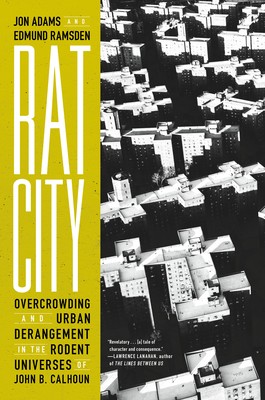
- We will send in 10–14 business days.
- Author: Jon Adams
- Publisher: Melville House Publishing
- ISBN-10: 1685890997
- ISBN-13: 9781685890995
- Format: 15.2 x 22.9 x 2.8 cm, kieti viršeliai
- Language: English
- SAVE -10% with code: EXTRA
Reviews
Description
How one experiment in rat behavior effected the re-making of society in the post-WWII boom years. How did the famous rat experiments of John B. Calhoun come to influence the thought behind social design, understandings of urban decay and regeneration, city planning as social control, and ultimately around the malleability of human nature. In 1947, ecologist John B. Calhoun came from the backwoods of Tennessee to the back-alleys of Baltimore. The city had hired him to kill rats. But to understand how to kill rats, he first had to learn how they lived. Over the next 3 decades, Calhoun built a series of experimental "Rat Cities" to observe his rodents, and subsequently to test their tolerance of population density. As the Rat Cities became ever more crowded, their residents began to exhibit increasingly severe reactions to social stress:- Mothers neglected their young
- Males became violent and hyper-sexual
- Others withdrew into complete social isolation, grooming obsessively and feeding alone
Unable to reproduce, the populations dwindled to extinction in what Calhoun called "a behavioral sink." As rising crime and social disorder swept through 1960s America, the Rat Cities predicted a bleak future for an increasingly crowded planet. Though they're markers of urban decay, this book illustrates that rats can be the catalyst for positive social change. In a mix of weird, dystopian science and bleak urbanist social history, this is the strange story of how an attempt to eliminate inner city rats became a symbol for how to understand human nature.
EXTRA 10 % discount with code: EXTRA
The promotion ends in 24d.00:24:00
The discount code is valid when purchasing from 10 €. Discounts do not stack.
- Author: Jon Adams
- Publisher: Melville House Publishing
- ISBN-10: 1685890997
- ISBN-13: 9781685890995
- Format: 15.2 x 22.9 x 2.8 cm, kieti viršeliai
- Language: English English
- Mothers neglected their young
- Males became violent and hyper-sexual
- Others withdrew into complete social isolation, grooming obsessively and feeding alone
Unable to reproduce, the populations dwindled to extinction in what Calhoun called "a behavioral sink." As rising crime and social disorder swept through 1960s America, the Rat Cities predicted a bleak future for an increasingly crowded planet. Though they're markers of urban decay, this book illustrates that rats can be the catalyst for positive social change. In a mix of weird, dystopian science and bleak urbanist social history, this is the strange story of how an attempt to eliminate inner city rats became a symbol for how to understand human nature.


Reviews